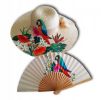How to paint salt pastes?




salt dough "drinks", so it's easy to paint. Acrylic paint (for wood or fabric) is very suitable (avoid gouache, which can crack).
What a pleasure it is to choose precisely a set of shades that will harmonize with each other!
By "stretching" the colors (wetting the brush abundantly), you obtain a more natural paint that blends into the relief.
| By using two (or more) complementary colors, you obtain more sophisticated effects. | |
| The first color must be dry before applying the next, otherwise it will be omitted by the brush stroke. This can give, for example, a lasured paint effect for furniture (with a light but darker second coat) or a silk effect (with a golden second coat). |
 |
 |
As for brushes, it's essential to have a whole range of them, especially a very fine one (n°000). The size of this pot is that of a little finger! |
Thevarnish
The pleasure here lies only in the fact that the modeling is almost ready... a thankless task, but essential to protect against both dust and humidity (which would permanently alter the modeling).
Two to three coats are even necessary, on both sides of your salt dough creation. You can use a wood varnish, matte or gloss: it all depends on the desired effect. Spray varnish is by far the most practical if you have a well-ventilated room.
varnished salt dough in the kitchen is highly resistant to humidity.



